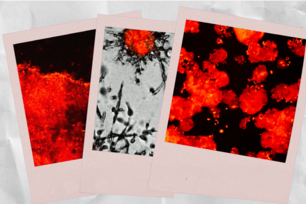New DNA Chip Method Could Improve Cancer Diagnosis
CAMBRIDGE, Mass. — One of the biggest challenges in cancer treatment is choosing the right regimen for a given patient. Treatment strategies work differently for different tumors. In choosing effective treatments with minimal side effects, oncologists rely heavily on biopsy reports that diagnose the tumor type involved. However, even today, cancer diagnosis is done the old-fashioned way: by observing morphological changes in biopsies under the microscope. The method suffers from serious limitations because cancer cells that look similar under the microscope can follow different clinical courses and respond differently to therapy.
Now, in a new study reported in Friday's Science,a team of Whitehead-led researchers reports the first systematic and objective approach for identifying and classifying tumor types. This approach exploits the hot new technology of DNA microarrays—DNA chips that can analyze the activity of thousands of genes at a time and could be used in the future to accurately diagnose cancer subtypes and also to predict clinical outcomes. Moving cancer diagnosis away from visually based systems to such molecular based systems is a major goal of the National Cancer Institute.
In the study, scientists used a DNA chip to examine gene activity in bone marrow samples from patients with two different types of acute leukemia--acute myeloid leukemia (AML) and acute lymphoblastic leukemia (ALL). Then, using a computer algorithm, also developed at the Whitehead, they identified signature patterns that could distinguish the two types. When they cross-checked the diagnoses made by the chip against known differences in the two types of leukemia, they found that the chip method could automatically discover the distinction between AML and ALL without previous knowledge of these classes.
"These results demonstrate the feasibility of cancer diagnosis based solely on gene expression and suggest a general strategy for discovering new subtypes of cancer, independent of previous biological knowledge. This is a critical first step in improving treatments for cancer patients," says Todd Golub, first author on the paper, who holds joint appointments at the Whitehead/MIT Center for Genome Research and the Dana-Farber Cancer Institute.
"The implications of this research study are tremendous," says Dr. Eric Lander, Director of the Center for Genome Research at the Whitehead Institute. "It suggests that we may be able to use DNA arrays in a variety of clinical settings for confirming diagnoses, clarifying unusual cases and measuring patients' response to drugs. It may also provide an objective way to predict clinical outcome for patients."
Distinguishing the two types of leukemia is critical for successful treatment of the disease because chemotherapy regimens for the two vary considerably. And, although the distinctions between AML and ALL are well established, no single test is currently sufficient to establish the diagnosis, researchers say. Current clinical practice involves a battery of tests, each performed in a separate, highly specialized laboratory, that have to be interpreted by an experienced pathologist.
In the study, Dr. Golub, Dr. Lander, and their colleagues set out to develop a more systematic and objective approach to cancer classification, using acute leukemia as their test case. The scientists first sought to create a so-called "class predictor" that could classify new, unknown samples based on already known differences in the two types of leukemia. Using California-based company Affymetrix's GeneChip® probe array, the scientists measured the activity of nearly 7,000 genes in the bone marrow samples of 38 patients. This provided scientists massive amounts of complex raw data. The fundamental challenge was then to find which of these 7,000 genes are important in determining cancer types, i.e. to find a signature pattern amid a sea of noise. Scientists used a computer algorithm to find differences in patterns of expression that classified the samples into the two types based on known information about AML and ALL.
Next, scientists tested whether the method could discover the distinction between the two types without prior knowledge of the two classes. This time, they used a different strategy to analyze the raw data. Scientists used a sophisticated computer algorithm called a "self-organizing map" (SOM) that takes advantage of the fact that many genes in a cell behave similarly and organizes the data into clusters with similar patterns. SOMs have been used widely in data mining, particularly for large or messy data sets like stock market data, but Whitehead scientists were the first to apply it to gene analysis.
The SOM organized the bone marrow samples into two distinct clusters based on the expression pattern of the 6817 genes. When scientists compared the two clusters to the known AML and ALL classes, the data matched effectively, suggesting that this was a fast, viable and highly promising method for cancer diagnosis.
"Although DNA arrays have been used in expression profiling of healthy and diseased cells, this is the first time that the technology has been applied to classify cancer types," says Dr. Golub.
The scientists say that it may be possible to do this for other cancers, and they plan to investigate this in the coming months.
The study was supported in part by the Leukemia Society of America, the National Institutes of Health, and the Leukemia Clinical Research Foundation. The study was also supported by a consortium of three companies—Bristol-Myers Squibb Company; Affymetrix, Inc.; and Millennium Pharmaceuticals Inc.—that have formed a unique corporate partnership to fund a five-year research program in functional genomics at the Whitehead's Genome Center.
The title of the Science paper is "Molecular Classification of Cancer: Class Discovery and Class Prediction by Gene Expression Monitoring." The authors are:
Citation
Golub, T. R., Slonim, D. K., Tamayo, P., Huard, C., Gaasenbeek, M., Mesirov, J. P., ... & Lander, E. S. (1999). Molecular classification of cancer: class discovery and class prediction by gene expression monitoring. Science, 286(5439), 531-537.
Topics
Contact
Communications and Public Affairs
Phone: 617-452-4630
Email: newsroom@wi.mit.edu



